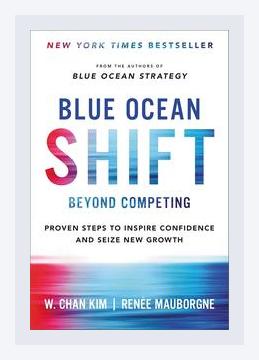Business StrategyCompetitive StrategyBlue Ocean Strategy
“Blue Ocean Shift” is a comprehensive guide that expands on the concepts introduced in “Blue Ocean Strategy” by W. Chan Kim and Renée Mauborgne. The book outlines detailed, step-by-step methodologies for organizations to move from highly competitive markets (“red oceans”) to untapped new markets where competition is irrelevant (“blue oceans”). It underscores the importance of shifting one’s mindset and providing actionable steps to achieve outstanding growth and innovation.
1. Concept of Blue Ocean Strategy
Major Point:
Kim and Mauborgne explore the essence of Blue Ocean Strategy, contrasting it with traditional competitive strategies that focus on outperforming rivals.
Concrete Example:
Cirque du Soleil combined elements of circus and theater, eliminating traditional circus elements like animal acts and focusing on artistic storytelling, thereby creating a new market space and enjoying significant success.
Actionable Step:
Identify industry pain points and not just how to compete better within the existing parameters but look for ways to create entirely new categories.
2. Humanness and Inspiration in Strategy Formation
Major Point:
Strategies need to inspire and align emotionally with people in the organization to drive genuine commitment and confidence.
Concrete Example:
CitizenM, a hotel chain, redefined affordable luxury lodging by eliminating the traditional reception desk and adding a living room-like lobby, which catered to modern travelers seeking both savings and comfort.
Actionable Step:
Engage team members in the process of strategic change, involve them in brainstorming sessions to understand their concerns, and align the vision with their values.
3. Steps to Create Blue Oceans
Major Point:
The book outlines five systematic steps for companies to transition from red oceans to blue oceans: Choosing the right starting point, building the right team, stepping out of existing boundaries, focusing on the big picture, and finding out how to execute the strategy.
Concrete Example:
US healthcare’s CVS MinuteClinic stepped out of the traditional hospital setting to provide convenient, affordable care in retail locations, carving out a new market space.
Actionable Step:
Analyze market demand and team up with innovative thinkers to brainstorm uncharted areas where you can deliver exceptional value.
4. Shift Projects: Opportunities for Practical Application
Major Point:
Shift projects are used to illustrate how different entities, from corporations to non-profits, have successfully applied blue ocean principles.
Concrete Example:
Malaysia’s AirAsia redefined air travel by focusing on cost leadership, transforming no-frills flying into a new market segment.
Actionable Step:
Draw inspiration from varied shift projects in the book and apply similar brainstorming sessions to your own organization to identify unnoticed opportunities and benefits.
5. Humanness and Inclusiveness in Strategy
Major Point:
Bringing in human factors and inclusiveness in strategy implementation allows for a more organic adoption of new ideas.
Concrete Example:
The case of a lone middle manager at a Swedish home appliance manufacturer who used the blue ocean principles to introduce a profitable business segment for professional dishwashers.
Actionable Step:
Encourage bottom-up contributions by creating a company culture where even minor voices are heard and their innovative ideas tested.
6. Overcoming Key Organizational and Economic Hurdles
Major Point:
Identifying and surmounting organizational hurdles is crucial in the journey toward a blue ocean shift.
Concrete Example:
Bundaberg Brewed Drinks redefined their ginger beer market by focusing on the historical, natural brewing process and unique packaging, steering away from the highly competitive soda market.
Actionable Step:
Use visual aids such as market transition maps to observe current market boundaries and focus on the big picture rather than on incremental improvements.
7. Value Innovation
Major Point:
Value innovation is the cornerstone of blue ocean strategy; rather than competing in the existing marketplaces, companies should find ways to deliver unprecedented value.
Concrete Example:
The French company Groupe SEB innovated with ActiFry, a low-fat fryer that revolutionized cooking techniques by addressing the growing health consciousness.
Actionable Step:
Review your product or service and identify the functional and emotional appeal to innovate on both dimensions.
8. Leadership and Organizational Capabilities
Major Point:
Effective leadership that guides and empowers employees to explore uncharted territories is central to implementing a blue ocean shift.
Concrete Example:
Nespresso’s leadership prompted them to carve out a niche market focused on the high-end, convenient coffee experience.
Actionable Step:
Foster a leadership style that encourages experimentation and calculated risk-taking, fostering a culture of innovation.
9. The Importance of Fair Process
Major Point:
The book discusses the need for treating people fairly and involving them in the decision process to gain their trust and commitment.
Concrete Example:
The case study on the Montreal Canadiens hockey team illustrated how involving team members in strategic decisions led to increased morale and better performance.
Actionable Step:
Implement fair process by engaging team members actively in strategy meetings, clearly explaining decisions, and allowing for robust feedback loops.
10. Systemic Risks and Market Testing
Major Point:
Overcoming the fear of systemic risk is essential, and product validation through market testing can reduce uncertainties.
Concrete Example:
New York Times used blue ocean strategies to combat the decline in print readership by launching digital-only subscriptions which catered to a different audience.
Actionable Step:
Initiate small-scale pilot projects to test market viability, gather feedback, and make necessary adjustments before broader implementation.
11. Consumer Target Opportunities: Noncustomers
Major Point:
Focusing on noncustomers rather than fighting for a larger slice of the current market leads to growth into untapped markets.
Concrete Example:
The example of Curves, a women’s fitness center, shows targeting women who were historically noncustomers of traditional gyms created a new blue ocean.
Actionable Step:
Identify noncustomers in your industry who are overlooked or underserved and design products/services tailored to their specific needs.
Conclusion
“Blue Ocean Shift” provides a clear roadmap for organizations aiming to innovate and grow beyond the crowded space of competitive markets. By incorporating human-centered strategies, fair process, and strong leadership, and focusing on noncustomers, the book offers actionable methods to create new demand in an uncontested market space. Readers are encouraged to reframe their strategic thinking and embark on a practical journey to achieve lasting success.
